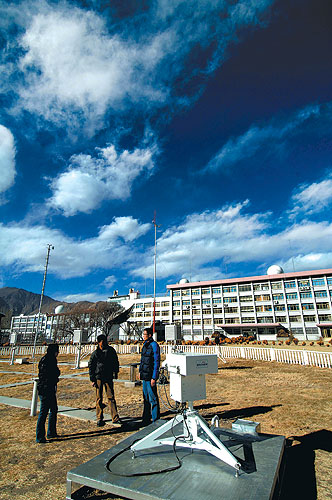|
 In 2007 the government spent 75.14 percent more than the previous year for scientific research and technological progress. Here is the Lhasa Meteorological Station.
In 2007 the government spent 75.14 percent more than the previous year for scientific research and technological progress. Here is the Lhasa Meteorological Station.
There was further development of science and technology in Tibet in 2007. The TAR government spent 190 million Yuan on science and technology, an increase of 75.14 percent over the previous year. Support was emphatically given to the application and popularization of advanced and applied technology in the fields of characteristic agriculture and animal husbandry, biology on the plateau, Tibetan medicine, new energy sources, ecological construction and environmental protection. After making a comparison on the status of Tibet's science and technology in the present and past, Zhalho, an expert of the Chinese Academy of Social Sciences on ethnic issues, found that, before the peaceful liberation of Tibet in 1951, no research institute on modern science and technology could be found in Tibet and there were less than 100 personnel engaged in Tibetan medicine and astronomical calendar. In 2007, Tibet had 40 scientific research institutes, 140 organizations at various levels for popularizing science and technology on agriculture and animal husbandry, about 400,000 professional technical personnel including some 2,000 ones engaged in scientific research. There were also nine key laboratories and engineering technology research centers as well as 40-odd science and technology demonstration bases of various kinds. In addition, Tibet set up 48 weather stations, six meteorological observatories with radar installations, seven cloud map receiving stations, 17 seismic stations and 32 water monitoring stations.
The year 2007 saw a fund of 156 million Yuan for science and technology from the State and the autonomous region. In the year, Tibetan research specialist staff undertook 21 State scientific and technological programs and 78 key scientific and technological programs at autonomous region level, with one item of scientific and technological achievement above provincial and ministry level. In addition, it submitted 97 patent applications, 68 of which were accepted.
Recent years have witnessed remarkable achievements made by Tibet in its scientific and technological industrialization, especially in the adoption of the results of the key scientific and technological items on agriculture and animal husbandry. The contribution rate of science and technology in agriculture and animal husbandry reached 35 percent and that for the overall economic growth 28 percent. In 2007, the Tibetan Scientific and Technological Enterprise Incubator was established in Chengdu, attracting 16 enterprises initially.
Tibet is conducting more than more international scientific and technological exchanges. Currently, it has set up science and technology exchanges and cooperative relationships with 10 countries, signing many agreements. From 2001 to 2005, more than 30 science and technology groups were sent overseas, with 240-plus person/times taking part in international academic conferences on science and technology and conducting cooperative research, and so on. At the same time, Tibet invited some 50 groups of foreign experts and scholars, totaling 350 person/times. It also hosted 135 groups of foreign scientific investigation groups with over 810 person/times. The international scientific and technology cooperation developed into the more substantial cooperative research, exchanges of scholars and cooperative development, and so on.
(China's Tibet facts and Figures 2008) |
